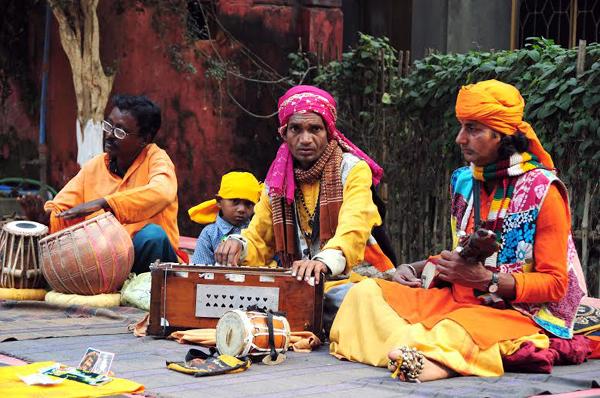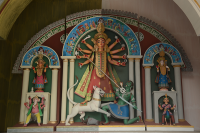 image
image
Song of the soil
Folk songs are an integral part of any society. However, under relentless pressure of industrialisation and globalisation many formats seem to be in danger of disappearing forever. Hence the revival of peoples interest in folk music of Bengal is an encouraging sign. Uttara Gangopadhyay reports
“My fair Tusu has become dark after visiting Kolkata because of the city’s saline water,” goes the lamentation of the folk singer describing Tusu’s misfortunes. Usually worshipped in the rural hamlets of the western region of Bengal and in the Chhota Nagpur tribal belt, Tusu is a folk goddess, the protector of crops. But when the workers in the coal belt adapted their agrarian lifestyle to that of the miner, it had an impact on their songs too. The sympathy for their fair-skinned goddess in their tusu song is a reflection of their own agony of having to adjust to a new lifestyle.
One also finds the strains of jhumur songs in the songs sung by the tea garden workers of north Bengal. Jhumuris from Purulia district. So when the people from Purulia went to work in the tea gardens, they carried their genre of music with them. But life in the tea gardens was vastly different from that in Purulia. The lyrics too changed accordingly.
“We may not have a separate genre of industrial folk songs like those found abroad, say in the US, but some of our folk songs come close,” explains Kalikaprasad Bhattacharya, an eminent singer and research scholar, and the mentor to an extremely popular television reality show in Bengali. The recently concluded musical show put great emphasis on the folk genre of Bengal, as well from neighbouring states in eastern India, and kept not only the home crowd but also the diaspora audience spell bound with the variety and ethnic appeal. .jpg)
Folk songs, after all, are an integral part of any society. People draw their inspiration from their own lifestyle, their environment, their profession, their social calendar and myriad other things and interpret them in their own way. For example, in the agomoni song, usually sung prior to Bengal’s biggest festival, Durga Puja, the goddess is seen not only as a demon-slayer as depicted in the religious scriptures but also as the married daughter who returns to her parental home every autumn, reflecting the excitement and the anguish of a mother looking forward to her daughter’s visit from a faraway land.
Although few people are aware of Bengal’s repertoire of folk songs, experts believe there are 30 to 35 formats that are still prevalent though it is well-nigh impossible to put a figure to the actual number of formats. The number of formats can easily increase if one considers that Bengal’s repertoire of folk songs date from the days when both West Bengal and Bangladesh were part of one unified region.
Among the region-based formats, there are bhawaiya, gambhira, jhumur,bhadu, tusu, etc. “The folk songs are also a lesson in regional geography, customs, etc.,” points out Bhattacharya. “The tempo of bhatiyali songs is very slow. It is sung by the boat people of lower Bengal where the rivers flow slowly and the boat follows in its wake. The boatman has enough time to reflect on life’s philosophies. But nouka baicher gaan, also a boatman’s song, has a fast tempo because the boat goes against the tide and the boatmen have to ply their oars in unison and with all their might.”
Folk songs borrow from any and every aspect of life. When the building of concrete building came into vogue, the labourers spun their own songs to seek relief from the hard work. Called chaat petanor gaan, they are a musical record of the labourers’ hard life and the urbanisation they saw around them.
Sometimes, the content of songs is the same but the names are different—gambhira of Malda district and gajanof south Bengal are sung in honour of Lord Shiva. Hindus and Muslims have their own set of wedding songs that talk about the new life that a girl is going to enter, how to conduct herself, etc..jpg)
The bauls or the singing minstrels of Bengal are a class apart. The mysticism of life, the search for the divine, etc. are main topics of their songs. Although baul music verges on the spiritual, it does not have any particular religion in mind; there are various sub-sects but that is based on their philosophical beliefs rather than on religious rituals. During Makar Sankranti (mid-January), bauls from India and Bangladesh congregate at an annual meet on the banks of the Ajay River in West Bengal’s Birbhum district; this is a good opportunity to learn about baul songs and philosophy. Baul is now recognised by UNESCO as an “intangible cultural heritage of humanity.”
Folk songs are mostly an oral tradition. Only very recently efforts are being made to record them for posterity. “It’s important to draw a musical map of Bengal,” believes Bhattacharya. Not only songs but the indigenous instruments are also disappearing one by one. One such casualty is the violin-like Sarinda. Sometimes, it is the musical instrument that indicates the region from where the singers originate; for example, the bauls of Birbhum district use a string instrument called Khamak but those from Nadia district do not do so.
Urbanisation, the pressure from mainstream media and other reasons are leaving an impact on the old folk songs. Alan Lomax writes in his book, Folk Song Style and Culture, “Big governments, national education, information network and worldwide marketing systems kill of cultures that do not conform to those of the power centres.”
According to experts, it is rather difficult to sustain urban people’s interest in folk songs because the format is more suited to the rural background. To portray them on stage by keeping the feel intact is difficult indeed. “Therefore, we believe in-situ preservation is so important,” says Amitava Bhattacharya of Banglanatak dot com, an organisation that essentially works to guide and train rural artisans—across crafts and music—to become economically self-sufficient. “While we hold exhibitions in India and abroad to showcase the art form, be it music or crafts, we also encourage artists to practice in their own villages. It is a way to inspire the younger generation too.” To facilitate, they hold various fairs and cultural programmes in the districts to draw the attention of the urban people. Practising artists and those who want to know about these indigenous cultures and folk music can stay with artists too.
On a positive note, Banglanatak’s efforts to build a bridge between the local artists and the urbanites, and the exposure of the richness of folk music showcased on a mainstream media channel have seen a revival of people’s interest in the traditional repertoire of folk songs of Bengal. To sustain the interest is the main challenge.
Top Headlines
-
Art and Culture
Saptak Music School of Pittsburgh hosts spellbinding evening of Indian classical music
September 23, 2025
-
Art and Culture
Zigzag to clarity: Sonal Mansinghs dance of life captivates Delhi
September 08, 2025
-
Art and Culture
USA: Santoor Ashram Kolkata mesmerises Los Angeles with a celebration of Indian classical music
August 27, 2025
-
Art and Culture
'Feels like a tonic in my musical pursuits': Flute virtuoso Pandit Ronu Majumdar receives Padma Shri
June 06, 2025
-
Art and Culture
Of Paris, a chronic pain and a pivotal friendship: Frida Kahlo meets Mary Reynolds at the Art Institute of Chicago
April 16, 2025
-
Art and Culture
Prabha Khaitan Foundation celebrates 'Vasant Utsav' at Indian Museum Kolkata
March 15, 2025
-
Art and Culture
Musical concert 'Ami Bhalobashi Bangla Ke' to be held in Kolkata on April 19
February 20, 2025
-
Art and Culture
A kiss in front of The Kiss? Vienna museum's V-Day offer is ode to Klimt's artistic masterpiece
February 10, 2025
-
Art and Culture
Dalhousie Square: Timekeeping with Kolkata's British gems
January 12, 2025
-
Art and Culture
Annapurna Devi: An absent protagonist
January 11, 2025

